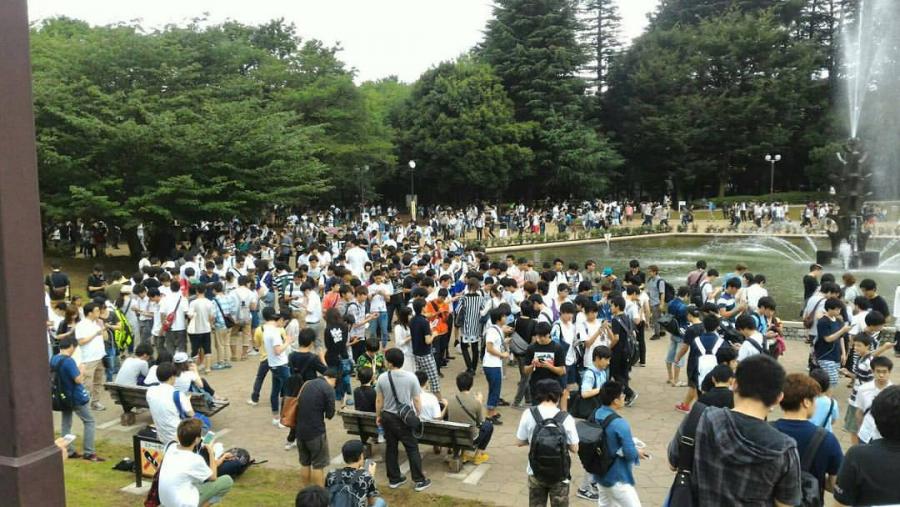
What Pokémon Go teaches us about society
In this small article, Jan Blommaert (Tilburg University) reflects on the Pokemon Go - hype. This mega-event of the summer of 2016 is an excellent example of the 'realness' of online phenomena.
The summer of 2016 was full of sports. There was the European football championship, almost instantly followed by an epic Tour de France and then spilling over into the Olympic Games. All of these were global competitive events. But the competition that wove itself through all of this, and was equally global, was entirely different. It consisted of millions of people all over the world going out in the streets with their smartphones ready, hunting for Pokémon cartoon creatures. The mega-event of the summer of 2016 was Pokémon Go.
This new-generation, “enhanced” version of the two decades old video- and card game broke down the boundaries of the timespace within which so many contemporary forms of hi-tech popular culture are being practiced and within which they are contained.
Pokémon started as a game in 1995 and became very popular when it was turned into a manga-style children’s TV series around the turn of the century. In my house, you will still find dozens of Pokémon merchandising items from that era, as my then-small children were greatly knowledgeable about nearly every aspect of the strange world of creatures, trainers and battles. Now in their early twenties, they took to the streets this summer to hunt and collect the same creatures. A comatose fantasy world had been brought back to life; Nintendo shares went crazy on the stock market.
The thing was considered weird by many. Flocks of people, staring at their smartphone screens, would walk and congregate, apparently aimlessly, in streets, parks, shopping malls, pubs, museums and private backyards; when overheard, they produced a cryptic jargon that could trigger smiles, jealous faces, and shrieks of amazement from others; at times they would stop, point their device in some direction – where I didn’t see a thing – and subsequently groaned “yessss!”. The news brought reports of traffic accidents caused by Pokémon enthusiasts, and YouTube showed clips (“epic fail” style) of people crashing into obstacles while concentrating on the events on their smartphone screens. Mayors and Police chiefs contacted Nintendo and called for restrictions on the placing of Pokémons in certain zones, and Brussels Airport politely requested the company to disable Pokémons on the airport tarmac and in the security screening area. The hype was seen by many as disruptive, silly, pointless and irritating. Like any hype, one supposes.
Pokémon go was disruptive. This new-generation, “enhanced” version of the two decades old video- and card game broke down the boundaries of the timespace within which so many contemporary forms of hi-tech popular culture are being practiced and within which they are contained. This timespace is that of the “virtual” world – more concretely, a screen. People engage with such forms of culture while sitting behind a screen in long uninterrupted bursts of activity, quietly and often invisible for all others who do not participate in it. Such forms of culture are, thus, spatiotemporally quite effectively niched. Parents would complain that their children spend long hours doing “something” behind that screen, while the nature of the practices their children are involved in is poorly understood, or indeed greatly unknown to them.

Pokemon Go Setagaya Park Tokio
What the little smartphone app enabling Pokémon Go did, was to take such practices out of their usual spatiotemporal niches and bring them elsewhere, into the “real”, offline world, the public spaces where participants now mingle with nonparticipants – members of one culture encountering members of another culture, in a terrain now claimed by both. Going offline does not mean that the game is now shared by all; the boundary crossed is just that of the spatiotemporal seclusion typical of such forms of culture. But as I said, participants point their smartphones to something which remains invisible for nonparticipants, and get very excited by the presence of creatures that do not exist in the world of those who did not downloaded the Pokémon Go app.
So here is the sociological and anthropological significance of Pokémon Go: it makes visible – a rare occasion – and offers a glimpse of a cultural world that coexists with other cultural worlds, and which usually remains out of the gaze of the unengaged bystander. This cultural world, I said it, is often called “virtual”. I consider that an epic misnomer, and Pokémon Go demonstrates it: there is nothing “virtual” about millions of people all over the world performing cultural practices by means of a small hi-tech item, in public spaces not designed for such practices. It is a lesson in the complex cultural arrangements that characterize our world. Those who preferred to remain in denial – those who call it “virtual” – received an in-your-face warning that our society contains numerous communities, some small, some very large, of people engaging in practices not “normally” part of the cultural-canonical repertoire. We know these people, but we didn’t know the cultural registers they practiced. Or we believed they were not really, really real.
Well, ladies and gentlemen, Pikachu and Bulbasaur are really really, real. So if you meet them, have some courtesy.